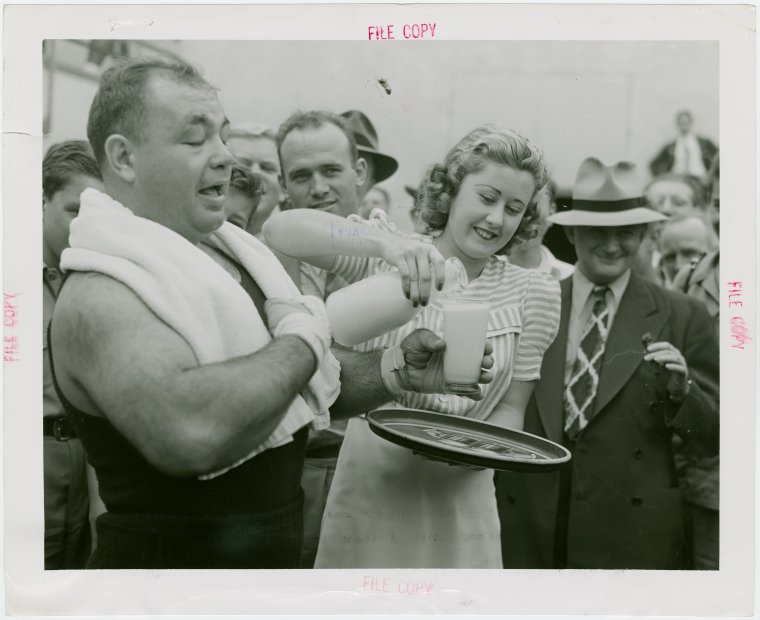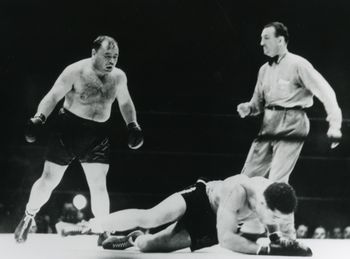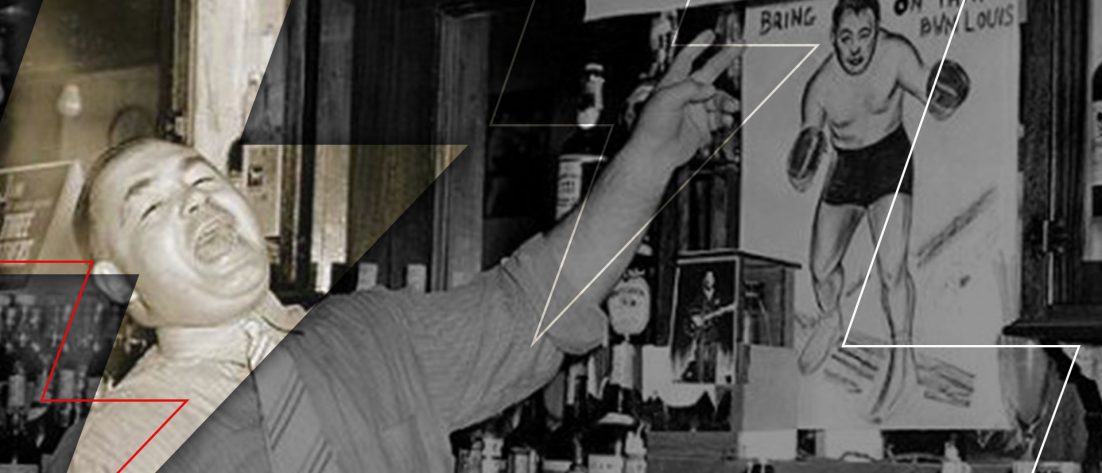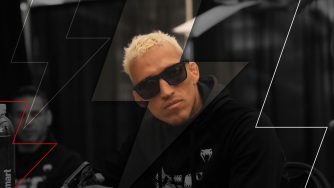At some unknown point along the developmental path of combat sports, a clever rascal made an important discovery. What if, instead of every single fighter vying to be the best and baddest at all possible times, there were also room for another kind of pugilist who was there to entertain? What if, in fact, that character leaned into how big and bad he wasn’t? What if he made a show of how totally not seriously he took all this, injecting a little lighthearted fun into the dire business of unarmed combat, while still being good enough at it to protect himself and win and give people a show?
Thus was born the concept of the clown fighter. And of all the people dubbed with that ungenerous moniker, and there were several who found their niche that way in the early to mid part of the 20th century, there may have been none more fascinating and simultaneously repellent than “Two Ton” Tony Galento.
Between 1928 and 1944, this ornery little bowling ball of a man fought 112 bouts, including an unsuccessful stab at Joe Louis’ heavyweight title in 1939. He stood just 5 feet 9 inches tall, short for a heavyweight even by the standards of the day. While other fighters had physiques that seemed to be made entirely of sharp, chiseled edges, when Galento stripped off his robe in the ring the prevailing feeling was of an overwhelming roundness. Round belly. Round torso. Round face. A dense, hairy boulder standing in the center of the ring and daring the hard men of boxing to try and dislodge him.

How did such a specimen make his way in the world of heavyweight boxing for so many years? How did he manage to win 79 professional bouts, and even manage to briefly floor the heavyweight champ in front of a crowd of nearly 35,000 in Yankee Stadium? The answer is wrapped up in some combination of toughness, personality, clever branding, and good old-fashioned, mean-spirited cheating.
Born in Orange, New Jersey, to a family of Italian immigrants, Galento claimed to have dropped out of school after the sixth grade and soon went to work delivering ice. The “Two Ton” nickname was supposedly given to him by a manager who demanded to know why Galento only arrived at the arena minutes before fight time for one of his early bouts. Gimme a break, Galento is said to have told the man. I had two tons of ice to deliver on my way here.

He started fighting in amateur bouts at 16, then went pro two years later, fighting mostly club bouts in his home state of New Jersey. After a few years of this he began to consider retiring from boxing when it appeared he’d never make it beyond the middle of the pack as a heavyweight. The turning point in his boxing career may have come when he joined forces with manager Joe Jacobs, a man ahead of his time in understanding the value of publicity to a prize fighter.
Jacobs, who was born in New York to a family of Hungarian Jews, had earlier became the unlikely manager of German fighter Max Schmeling, the unwilling darling of the Nazi Party. In the 1930s, Germany’s Reich Minister of Sports even demanded that Schmeling split from Jacobs due to Jacobs’ Jewish heritage, which prompted Schmeling to write directly to Adolph Hitler in order to explain how vital Jacobs was to his success.
Jacobs’ approach to management could be summed up in one of his early instructions to Schmeling: “You need publicity. Not a single day can go by without your name being in the papers.”
Schmeling later said that Jacobs “knew nothing about boxing, but he knew how to negotiate and get his man the best deal possible. And he was as nice as he was clever.”
Jacobs helped Galento see what could be gained by leaning into all the ways he differed from other heavyweights of the time. He circulated the stories of Galento’s prodigious drinking and eating (on a bet, Galento once at 52 hot dogs before a fight, then, despite barely being able to fit into his trunks, he won the fight via knockout). He made sure reporters received photographs of Galento doing things like chugging beer or “sparring” with a tire swing, which Jacobs would then caption: “Tony in training.”

This type of self-promotion suited Galento perfectly, and it wasn’t so much a gimmick as it was a magnifying glass on his true personality. Galento is said to have done very little training aside from sparring and a little jogging. Heavyweight great Jack Dempsey briefly worked with him but was supposedly “disgusted” by Galento’s lack of serious training. (Fun side note: Galento opened his own bar in his hometown of Orange, called “The Nut House,” and would sometimes do his road work after the place closed. When people asked why he didn’t do his running earlier in the day, Galento replied: “Because I fight at night.”)
Galento also seemingly never met a PR stunt he didn’t like. He once fought three men (with minimal boxing experience) in one night, dubbed the “Beeftrust Tournament.” He wrestled an octopus, sparred with a kangaroo and even a bear for the sake of a little media attention.
Not surprisingly, it worked. Galento was good copy for the sportswriters of the day. He was funny, crude, and most importantly he offered something different. Seemingly every other fighter at the time wanted people to see how hard he was working, how much he sacrificed in training and how badly he wanted to win. Galento could be found down at his bar, drinking alongside the customers with his round face hovering over a giant plate of chicken or pasta.
He also openly embraced the dirty side of the fight game, in more ways than one. Galento wasn’t afraid to headbutt opponents, or thumb them in the eye on purpose. He regularly hit below the belt, even when it cost him rounds. His 1939 bout with Lou Novo was called “one of the most disgraceful fights staged since the days of the barroom brawls,” by Ring Magazine. To Galento, it was all just part of the business.
“Who is this guy, Queensberry?” he reportedly said to a member of the New Jersey Boxing Commission, when pressed about his repeated failures to abide by the Marquess of Queensberry rules. “I don’t see anything wrong in sticking your thumb into any guy’s eye, just a little.”
Galento also sometimes intentionally ignored the principles of good hygiene in order to make fighting in the clinch even more unpleasant for his opponents. Former heavyweight champion Max Baer, who fought and beat Galento in 1940, later claimed he “smelled of rotten tuna and a tub of old liquor being sweated out.”
But by far the biggest moment of Galento’s career came when he got a shot at Louis’ heavyweight title. This was the part of Louis’ championship reign that he was most criticized for, with detractors dubbing the series of challengers he faced as the “bum of the month club.” It was one of the most active periods of competition for any heavyweight champion, with Louis defending the belt 13 times in a period of just over two years.
The way many reporters saw it, Galento was an undeserving challenger who’d been chosen for his colorful personality and ability to sell tickets. While Louis played the role of the humble and respectful champion, Galento verbally berated him both publicly and privately. When reporters asked about Louis in the lead up to the fight, Galento often pretended to have never heard of the champ, famously saying he’d “moida the bum.” Not content simply to hype the fight in the press, Galento also repeatedly called Louis at home and spewed racist invective about both Louis and his wife.
This infuriated Louis, as he admitted decades later when both men appeared together on a TV show looking back at their fight. It was the only fight he ever went into hoping to draw it out, Louis said, solely because he wanted to punish Galento for as long as possible.
“I really didn’t want to knock him out at all,” Louis said. “Maybe past the tenth round. Because he had been so bad, calling me all kind of names. …Only time it ever happened. Only time I’ve ever said that.”
What changed Louis’ mind was Galento’s powerful left hook. Though he didn’t look like much, short and fat and balding even in his late twenties, Galento really could fight a little bit. He had developed a close-in fighting style that suited his frame, and he could take tremendous punishment. Prior to the Louis fight, he’d supposedly never been knocked down. Galento’s personal physician once described him as “a throwback” due to him being “the thick‐boned, hyposensitive type which does not readily register pain.”
Galento’s short, clubbing left hook seemed to surprise Louis in the first round of their title fight. The champion looked genuinely stunned up against the ropes at points, though he quickly found his rhythm in the second frame, battering Galento and lifting him off his feet with one combination that floored the challenger. But Galento was game, coming back in the third to knock Louis down with that left hook, creating an enduring and almost comical image of one physically unimpressive fighter standing briefly triumphant over one of the greatest heavyweights of all time.

That moment of glory was extremely short-lived, however. Louis got back to his feet in a hurry and in the fourth round resumed a brutal beating of Galento, pasting him with repeated right hands until Galento turned and collapsed onto one knee against the ropes, prompting referee Arthur Donovan to finally stop the bout.
At the time, Galento claimed to be angry at the stoppage. He blamed his cornermen, saying they wouldn’t let him fight “his” fight, by which he likely meant a dirty fight that flowed outside the bounds of boxing rules. However, in later years Galento also claimed that he never listened to his trainers between rounds because “he’s not the one getting hit – I am.”
Galento would return to his rule-bending style in the next bout against Nova, in which he repeatedly thumbed his opponent’s eye en route to a knockout victory in the 14th round, though many observers thought he deserved to be disqualified well before that. His next two fights came against the Baer brothers, first Max and then Buddy, and he lost both, taking terrible punishment in each fight.
Soon after that, Galento began to drift away from life in the boxing ring. He did some pro wrestling, a little acting, even had a small role as a mob henchman in the 1954 Marlon Brando film “On the Waterfront.” He was never known as an easy man to get along with, and even some of his closest friends regarded him as unbearably crude and mean at times, though somehow also charming and funny at others. He once got into a fight with his own brother in the hours before one of his bouts, which led to his brother smashing a beer glass in his face and badly cutting his lip. Galento fought that night anyway.
He died in New Jersey in 1979, after several years of failing health related to diabetes. He’d had portions of both legs amputated by then, due to circulatory problems related to his condition, and finally succumbed to a heart attack that June at the age of 69.
Maybe one of the most revealing anecdotes about his personality outside of the ring came from the famous actor and comedian Jackie Gleason, who encountered Galento without realizing it one night while hosting an event at a Newark night club.
“I have made a few mistakes in my life, and that was one of the big ones,” Gleason told heavyweight great Rocky Marciano on the TV show “Main Event,” in 1960. “I was working at a joint called The Miami Club, in Newark. And it was a real tough joint. As a matter of fact, they called it ‘the bucket of blood.’ And one night I was doing the show and there was a little fat, bald-headed guy at the ringside. Every time I came out to introduce an act or tell a joke, he would say something derisive, you know, nasty. I was hoisting a few at the time, and I said to the owner of the joint, ‘That guy is driving me nuts.’ I said, ‘Now if he doesn’t stop, I’m going to take care of him.’”
“So I come out another time and he began to heckle. And I said, ‘Ladies and gentlemen, will you excuse me for a moment, I would like to invite this gentleman to step out on Clinton Avenue and I’d like to take good care of him and then we can do the show without any interruptions.’ I never saw anybody get up as fast as this guy did. Now we get out on Clinton Avenue. I said, ‘Now you’re going…’ and that’s the last I remember. The next thing I recall I was on the floor of the cellar, next to the furnace. A doctor was there, the owner of the joint. They had brought me to and I said to them, ‘Who was that guy?’ He said, ‘That was Tony Galento.’ I said, ‘Did you know it was Tony Galento?’ He said, ‘Sure.’ I said, ‘Well why didn’t you tell me?’ He said, ‘Well you’re a wise guy. I thought I’d let you go up against him.’ That was really a big mistake.”
Hey, if you made it this far and didn’t hate it, you should consider signing up for the Co-Main Event Patreon. There you can comment on these posts, argue with other people about them, even call us names or whatever. You also help support the CME and keep the discourse free and unfuckingfettered.









